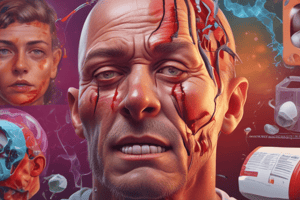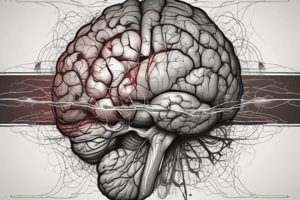Podcast
Questions and Answers
A 14-year-old teenager is hit on the side of the head in the region of the pterion by a cricket ball and becomes unconscious. After a few minutes the teenager regains consciousness, but gradually becomes lethargic. On arriving at hospital, a cranial haemorrhage is suspected.
Which vessel is the most likely source of the haemorrhage in this case?
A 14-year-old teenager is hit on the side of the head in the region of the pterion by a cricket ball and becomes unconscious. After a few minutes the teenager regains consciousness, but gradually becomes lethargic. On arriving at hospital, a cranial haemorrhage is suspected.
Which vessel is the most likely source of the haemorrhage in this case?
- accessory meningeal artery
- deep auric artery
- middle meningeal artery (correct)
- posterior deep temporal artery
What type of haemorrhage is the most likely consequence of a rupture to the artery (from Question 1) by the cricket ball?
What type of haemorrhage is the most likely consequence of a rupture to the artery (from Question 1) by the cricket ball?
- extradural haemorrhage (correct)
- intracerebral haemorrhage
- subdural haemorrhage
- subarachnoid haemorrhage
The impact at the pterion probably caused a rupture of the blood vessel at that point. However a fracture near to the region where the MMA artery enters the skull is also possible.
Which foramen does the artery use to access the cranial cavity?
The impact at the pterion probably caused a rupture of the blood vessel at that point. However a fracture near to the region where the MMA artery enters the skull is also possible. Which foramen does the artery use to access the cranial cavity?
- foramen lacerum
- foramen rotundum
- foramen spinosum (correct)
- jugular foramen
The middle meningeal artery supplies parts of the cerebral hemispheres. TRUE or FALSE?
The middle meningeal artery supplies parts of the cerebral hemispheres. TRUE or FALSE?
The foramen (from Question 4) sits within which bone?
The foramen (from Question 4) sits within which bone?
Indigo is a 20-day-old baby born via a vaginal delivery at term. Indigo has no previous medical history. Their mother has brought them to the Emergency Department as they are refusing the bottle and are not very responsive.
After a thorough examination you suspect that Indigo may have an infection, their anterior fontanelle is bulging and a rash has developed. You ask your consultant for advice and they suspect meningitis.
Leptomeningitis is inflammation in which meninges?
Indigo is a 20-day-old baby born via a vaginal delivery at term. Indigo has no previous medical history. Their mother has brought them to the Emergency Department as they are refusing the bottle and are not very responsive.
After a thorough examination you suspect that Indigo may have an infection, their anterior fontanelle is bulging and a rash has developed. You ask your consultant for advice and they suspect meningitis.
Leptomeningitis is inflammation in which meninges?
During a fight outside a nightclub, a person receives a penetrating knife wound that causes significant injury to the left glossopharyngeal nerve.
From the following list of symptoms, which one could be the result of a lesion to the glossopharyngeal nerve?
During a fight outside a nightclub, a person receives a penetrating knife wound that causes significant injury to the left glossopharyngeal nerve.
From the following list of symptoms, which one could be the result of a lesion to the glossopharyngeal nerve?
Given the exit location of the glossopharyngeal nerve from the skull (from Question 7), which of the following cranial nerves could also have been compromised as a result of the injury?
Given the exit location of the glossopharyngeal nerve from the skull (from Question 7), which of the following cranial nerves could also have been compromised as a result of the injury?
A 25-year-old person was diagnosed with multiple sclerosis, a disease that causes demyelination in the CENTRAL NERVOUS SYSTEM. Their symptoms included muscle weakness, spasticity, impairment of vibratory/position, pain, temperature and touch sensations.
Destruction of which type of cells is MOST LIKELY to cause the impairment of her motor and sensory functions?
A 25-year-old person was diagnosed with multiple sclerosis, a disease that causes demyelination in the CENTRAL NERVOUS SYSTEM. Their symptoms included muscle weakness, spasticity, impairment of vibratory/position, pain, temperature and touch sensations.
Destruction of which type of cells is MOST LIKELY to cause the impairment of her motor and sensory functions?
Local anaesthetic drugs exert their action by blocking what type of ionic transport?
Local anaesthetic drugs exert their action by blocking what type of ionic transport?
Which ion transport protein conducts the primary outward current driving rapid REPOLARISATION of the action potential?
Which ion transport protein conducts the primary outward current driving rapid REPOLARISATION of the action potential?
When a person is poisoned with tetrodotoxin, which blocks Na+ channels, how will this change the threshold voltage for initiating a neuronal action potential?
When a person is poisoned with tetrodotoxin, which blocks Na+ channels, how will this change the threshold voltage for initiating a neuronal action potential?
Which of the following statements is TRUE regarding membrane depolarisation beyond the threshold potential of a neuron?
Which of the following statements is TRUE regarding membrane depolarisation beyond the threshold potential of a neuron?
The specimen shown in the image is a brain slice taken at a post-mortem examination.
What is the most likely diagnosis?
The specimen shown in the image is a brain slice taken at a post-mortem examination.
What is the most likely diagnosis?
A 60-year old person presents with headache which has worsened over several weeks, is worse in the mornings and when coughing. They are suspected to have raised intracranial pressure.
What possible consequence would be your greatest concern if a colleague wanted to perform a lumbar puncture on this patient?
A 60-year old person presents with headache which has worsened over several weeks, is worse in the mornings and when coughing. They are suspected to have raised intracranial pressure.
What possible consequence would be your greatest concern if a colleague wanted to perform a lumbar puncture on this patient?
A 46-year old person suddenly experiences severe occipital headache for no obvious reason. They are also violently ill with nausea and vomiting. They have a stiff neck.
On admission, they are drowsy but respond when prompted/stimulated. They can move all four extremities. However, over the next 24 hours, they deteriorate and become comatose.
A 46-year old person suddenly experiences severe occipital headache for no obvious reason. They are also violently ill with nausea and vomiting. They have a stiff neck.
On admission, they are drowsy but respond when prompted/stimulated. They can move all four extremities. However, over the next 24 hours, they deteriorate and become comatose.
A 4-year old child complains of sore throat and has a fever with chills. They develop a headache and a lumbar puncture shows cloudy CSF which contains abundant neutrophils (neutrophilic granulocytes) on microscopy.
What is the most likely diagnosis?
A 4-year old child complains of sore throat and has a fever with chills. They develop a headache and a lumbar puncture shows cloudy CSF which contains abundant neutrophils (neutrophilic granulocytes) on microscopy.
What is the most likely diagnosis?
On Friday night in the Emergency Department, a 14-year-old teenager is admitted in a confused state and with a severe laceration to their head requiring suturing. It is clear that they have been drinking alcohol and they are admitted overnight for observation. The following morning they have no recollection of how they injured their head or the surrounding circumstances.
Alcohol interferes with which wave pattern essential for hippocampal memory formation?
On Friday night in the Emergency Department, a 14-year-old teenager is admitted in a confused state and with a severe laceration to their head requiring suturing. It is clear that they have been drinking alcohol and they are admitted overnight for observation. The following morning they have no recollection of how they injured their head or the surrounding circumstances.
Alcohol interferes with which wave pattern essential for hippocampal memory formation?
What other drug is known to interfere with the previous wave formation and impair memory formation?
What other drug is known to interfere with the previous wave formation and impair memory formation?
Alcohol may also directly interfere with the process of long term potentiation. Through agonism of which receptor is this likely to occur?
Alcohol may also directly interfere with the process of long term potentiation. Through agonism of which receptor is this likely to occur?
In regard to long term potentiation, which of the following ions ACTS as a second messenger?
In regard to long term potentiation, which of the following ions ACTS as a second messenger?
Regarding the neurobiology of learning and memory, which of the following is FALSE?
Regarding the neurobiology of learning and memory, which of the following is FALSE?
The major inhibitory neurotransmitter in the brain stem and spinal cord is ________.
The major inhibitory neurotransmitter in the brain stem and spinal cord is ________.
The NMDA receptor (an ionotropic glutamate receptor) conducts which of these ions?
The NMDA receptor (an ionotropic glutamate receptor) conducts which of these ions?
A person, aged 63, comes to the clinic. They feel that there is nothing wrong with them but their spouse has made them come. The spouse noticed that the patient has been increasingly forgetful and is having trouble finding words and remembering their grandchildren. Further neurological and cognitive testing suggests to you that the patient may be showing early symptoms of Alzheimer’s disease.
The _______ neurotransmitter system is most commonly seen to degenerate in Alzheimer’s Disease.
A person, aged 63, comes to the clinic. They feel that there is nothing wrong with them but their spouse has made them come. The spouse noticed that the patient has been increasingly forgetful and is having trouble finding words and remembering their grandchildren. Further neurological and cognitive testing suggests to you that the patient may be showing early symptoms of Alzheimer’s disease.
The _______ neurotransmitter system is most commonly seen to degenerate in Alzheimer’s Disease.
Some common drugs used to treat Alzheimer’s Disease act by inhibiting this neurotransmitter’s _________?
Some common drugs used to treat Alzheimer’s Disease act by inhibiting this neurotransmitter’s _________?
‘Semantic dementia’ refers to which definition?
‘Semantic dementia’ refers to which definition?
Flashcards are hidden until you start studying



